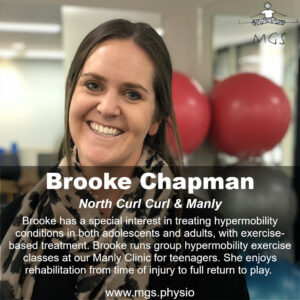
Hypermobility Spectrum Disorder (HSD) is a connective tissue condition resulting in increased joint mobility, joint instability and pain. Often those people who are described as ‘double jointed, floppy, overly flexible’ are sitting on the spectrum of hypermobility. There is an important role for diagnosis of HSD, particularly in young children/adolescents. Physiotherapists use Beighton scale, a joint hypermobility test on 9 joints, with HSD having a score of 6 or above out of 9. Proper management of HSD results in fewer episodes of joint instability, joint injury and pain. Physiotherapists play a key role in this management, with education and prescription of exercise-based rehabilitation.
Within the umbrella term of hypermobility spectrum disorder lies a group of hereditary connective tissue disorders called Ehlers-Danlos Syndromes (EDS). Importantly with EDS there are genetic causes and often underlying concern for abnormal structure or function of collagen and certain connective tissue proteins. Whilst EDS and HSD have similar characteristics such as joint hypermobility, joint instability and pain, EDS involves further connective tissue structures including spinal discs, joint deformities, skin hyperextensibility and scarring and organ structural weaknesses, including bladder and bowel. For this reason, formal diagnosis of EDS (and type of EDS) through genetic testing is hugely important in the overall management of the condition.
Unfortunately, diagnosis of EDS is often very slow, due to the rarity of the condition with 1 in 5,000 people being diagnosed (Pyeritz, 2000), disproportionally affecting women. However, it is thought that it is more common, due to late diagnosis and often misdiagnosis from poor understanding of both HDS and EDS.
While there is no cure for EDS, there are treatments and management strategies available via a multidisciplinary approach. A team of specialists are involved in managing patient care depending on the type of EDS diagnosed and current signs/symptoms. Physiotherapists play a vital role in the management of EDS patients, with exercise prescription, brace fitting/assistive devices, pain management and activity modification.
Further information and resources are available at https://www.ehlers-danlos.com/
Author –  Brooke Chapman (North Curl Curl)
Brooke Chapman (North Curl Curl)
Brooke has a special interest and has completed further training in treating hypermobility conditions in both adolescents and adults, with exercise-based treatment. Brooke runs group hypermobility exercise classes at our Manly Clinic for teenagers. She has worked with various sporting teams in netball, rugby, rowing, AFL and basketball and enjoys rehabilitation from the acute stage of injury to full return to play.
She is a local on the Northern Beaches, and on the weekends you will find her ocean swimming or anywhere near the water!
Click here to learn more about Brooke.
